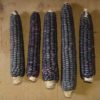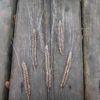Cascade Ruby-Gold flint corn
Price range: $4.00 through $15.00
(Zea mays)
Smaller and earlier than Iowne’s True Blue. Gives a mix of solid-coloured, 8-row ears: red, yellow, and copper. Bred by Carol Deppe in Oregon from a cross between Abenaki Flint from Vermont and Byron Flint from Maine, this is an interesting example of modern breeding of ancient corns to develop a new variety; Carol explains her logic and process in her excellent book The Resilient Gardener, and also describes this corn and gives recipes for its use far better than I can do. Cascade is useful for those who wish to save their own corn seed but live too near other corn growers to be sure of isolation distance; it finishes pollinating before field corns start, effectively maintaining its purity if you plant it soon enough. This will not work, however, if you plant other very early corns, the most common of which is Painted Mountain. Early-season; keep pure by timing and rogue out late-maturing plants. OSSI pledged. 120 days to maturity.
Wait until soil has warmed to 60° F/15º C to plant. Darker coloured seeds usually germinate better in cool soil. Plant 1-2” deep, four seeds to a hill (10” between them), spaced 40” on centre; or plant in rows 24” apart for early varieties, 30-40” apart for main season ones, with row spacing of 8-10” for early varieties and 10-12” for main season. Plants will pollinate for 2-3 weeks after tasseling; separate varieties by at least 500’ or plant successively so they will pollinate at different times. If doing succession plantings, let first variety reach eight-leaf stage before planting the next one. Save seed from at least 100 plants (preferably 200), selecting based on field characteristics of plant, not just on cob size.






